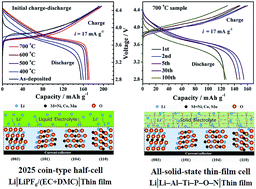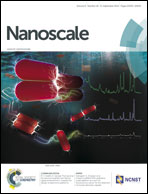Controllable crystalline preferred orientation in Li–Co–Ni–Mn oxide cathode thin films for all-solid-state lithium batteries†
Abstract
All-solid-state thin-film batteries are highly desirable for microelectronic devices because of their high energy densities, long lifetime, negligible self-discharge rates, flexibility in design, and enhanced safety performance. In this work, Li–Co–Ni–Mn oxide cathode thin films with controllable crystal orientation are prepared by radio frequency magnetron sputtering combined with in situ post-annealing at temperatures of 400–700 °C. The as-deposited thin film has an amorphous structure and develops layered structures during the annealing process. Nano-sized crystalline grains grow in the (104) plane at 400 °C, but they are oriented to the (110) plane at 700 °C. The (110) plane is considered to be the most favorable for fast lithium-ion diffusion in layered structures, and this preferred orientation is due to the minimization of the structural energy developed in the thin film during annealing. In cell tests, thin film cathodes with the controlled crystal orientation exhibit higher electrochemical performance than the amorphous thin film cathodes owing to their improved lithium-ion conductivity and interfacial resistance. The crystalline Li–Co–Ni–Mn oxide thin film is thus a promising candidate cathode material for all-solid-state lithium batteries.


 Please wait while we load your content...
Please wait while we load your content...